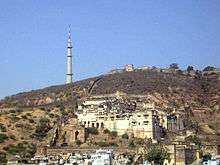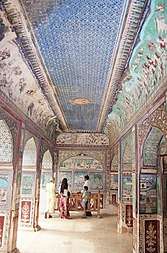Bundi
| Bundi | |
|---|---|
| town | |
 Panoramic view of the old town and palace of Bundi. | |
 Bundi Location in Rajasthan, India  Bundi Bundi (India) | |
| Coordinates: 25°26′N 75°38′E / 25.44°N 75.64°ECoordinates: 25°26′N 75°38′E / 25.44°N 75.64°E | |
| Country |
|
| State | Rajasthan |
| District | Bundi |
| Named for | Bunda Meena (tribal leader) |
| Elevation | 268 m (879 ft) |
| Languages | |
| • Official | Hindi |
| Time zone | UTC+5:30 (IST) |
| PIN | 323001 |
| ISO 3166 code | RJ-IN |
| Vehicle registration | RJ-08 |
| Sex ratio | 922 ♂/♀ |
| Website |
bundi |
Bundi is a town in the Hadoti region of Rajasthan state in northwest India. It is of particular architectural note for its ornate forts, palaces, and stepwell reservoirs known as baoris. It is the administrative headquarters of Bundi District. Bundi has many temples, so it is called "Chhoti Kashi" (Little Varanasi).
Geography
The town of Bundi is situated 35 km from Kota and 210 km from Jaipur. It is located at 25°26′N 75°38′E / 25.44°N 75.64°E and an average elevation of 268 metres (879 feet). The city lies near a narrow gorge, and is surrounded on three sides by hills of the Aravalli Range. A substantial wall with four gateways encircles the city. It is served by Bundi railway station on Kota-Chittorgarh rail line. Bundi is also known as "Choti Kashi" as there are many old temples in the city, which has been built by kings at their reign.
Demographics
In the 2001 Indian census,[1] Bundi had a population of 88,312. Males constitute 53% of the population and females 47%. Bundi has an average literacy rate of 67%, higher than the national average of 59.5%; with male literacy of 75% and female literacy of 57%. 14% of the population is under 6 years of age.
 An alley in the old town. Many of Bundi's houses are painted blue.
An alley in the old town. Many of Bundi's houses are painted blue. Street scene from Bundi, Rajasthan.
Street scene from Bundi, Rajasthan.- Lady in Bundi, 1986.
- Mother and child in Bundi, 1986.
History

Stone Age tools dating from 5,000 to 2,00,000 years were found in Bundi and Bhilwara districts of the state.[2]
In ancient times, the area around Bundi was apparently inhabited by various local tribes. Bundi and the eponymous princely state are said to derive their names from a former Meena tribe man(Sardar/king) called Bunda Meena. Bundi was previously called "Bunda-Ka-Nal", Nal meaning "narrow ways". Later the region was governed by Rai Deva Hada, who took over Bundi from Jaita Meena in 1342, and established a princely state Bundi, renaming the surrounding area called Hadoti, the land of great Hada Rajputs.
Bundi came under the Sisodia Rajputs of Mewar and the Hada rulers were their vassals until 1568, when Rai Surjan Singh submitted to Akbar after the fall of Ranthambore.
Tourist attractions

- Taragarh Fort, or Star Fort, is the most impressive of the city's structures. It was constructed in 1354 on the top of a steep hillside overlooking the city. The largest of its battlements is the 16th century bastion known as the Bhim Burj, on which was once mounted a particularly large cannon called Garbh Gunjam, or 'Thunder from the Womb'. The fort is a popular tourist viewpoint of the city below. The fort contains three tanks which never dry up. The technique with which they were built has been long since lost but the tanks survive as a testament to the advanced methods of construction and engineering in medieval India.
- Bundi Palace is situated on the hillside adjacent to the Taragarh Fort and is notable for its lavish traditional murals and frescoes. The Chitrashala (picture gallery) of the palace is open to the general public.
- The Nawal Sagar is a large square-shaped artificial lake in the centre of Bundi containing many small islets. A temple dedicated to Varuna, the vedic god of water, stands half-submerged in the middle of the lake. the lake feeds the numerous bavdis in the old city by creating an artificial water table
- Sukh Mahal is a cream-coloured palace that sits on the water bank. Rudyard Kipling stayed there and claimed that the palace inspired his novel Kim
- Chaurasi Khambon ki Chhatri, Bundi or Eighty four pillared cenotaph
Stepwells
There are over 50 stepwells in Bundi, of which only a handful have been maintained. They used to be the only source of water for the town until a piped water system was introduced. After that, these stepwells were abandoned and the monuments fell into disrepair. Most of the former stepwells inside the town have become refuse dumps, and are slipping out of the public consciousness.
The Raniji ki Baori is a noted and well-maintained stepwell, some 46 metres (151 ft) deep. It was built in 1699 by Rani Nathavatji. The steps built into the sides of the water-well made water accessible even when at a very low level. The baori is one of the largest examples of its kind in Rajasthan.
The Nagar Sagar twin step wells are identical step wells crafted in masonry on either side of the main spine of the town. The Dabhai Kund, also known as the Jail Kund, is the largest of the stepwells and, although slightly overgrown, still shows carvings on the numerous steps leading down to water level.
Murals
Murals in the typical Rajasthani Hadoti miniature style are an important attraction in the Garh Palace. They cover the walls, ceilings and niches in several of the pavilions or "mahals", depicting stories from the life of Krishna as well as scenes from the lives of the royalty. They have significant artistic and decorative values. The Ummed Bhavan "Chitrashala" (also in the Garh Palace, i.e. the palace premises within the Bundi fort) have especially notable murals.
Rock art
There are nearly 100 rock art sites in and around the town, some dating back 5000 to 7000 years. They have been discovered by a local enthusiast in the sandstone escarpments and caves. These show up the typical line drawings of wild buffalo, deer, tiger, etc. as well as humans in different postures that depict the typical lives and concerns of human beings of the period.
References
- ↑ "Census of India 2001: Data from the 2001 Census, including cities, villages and towns (Provisional)". Census Commission of India. Archived from the original on 2004-06-16. Retrieved 2008-11-01.
- ↑ Pillai, Geetha Sunil (28 February 2017), "Stone age tools dating back 2,00,000 years found in Rajasthan", The Times of India
Further reading
- Beny, Roland; Matheson, Sylvia A. (1984). Rajasthan – Land of Kings. London: Frederick Muller. p. 200 pages. ISBN 0-584-95061-6.
- Crump, Vivien; Toh, Irene (1996). Rajasthan (hardback). London: Everyman Guides. p. 400 pages. ISBN 1-85715-887-3.
- Martinelli, Antonio; Michell, George (2005). The Palaces of Rajasthan. London: Frances Lincoln. p. 271 pages. ISBN 978-0-7112-2505-3.
- Sodhi, Jiwan (1999). A Study of Bundi School of Painting (hardback). India: Abhinav Publications. ISBN 81-7017-347-7.
External links
| Wikimedia Commons has media related to Bundi. |
| Wikivoyage has a travel guide for Bundi. |
